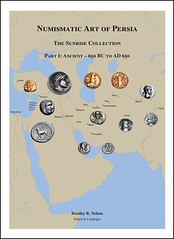
PREV ARTICLE
NEXT ARTICLE
FULL ISSUE
PREV FULL ISSUE
QUERY: REVIEW OF NUMISMATIC ART OF PERSIA SOUGHT
David Levy asks about a new numismatic book. Can anyone provide more information?
-Editor
Here's the link to it on the CNG website: www.cngcoins.com/Coin.aspx?CoinID=201395 Nelson, Bradley R., ed., Numismatic Art of Persia. The Sunrise Collection, Part I: Ancient – 650 BC to AD 650. 2011. Hardbound, $175 There's a description of the book but actually I wonder if any member had seen the actual book and would have a more critical review to share besides the publisher's own description. From the web site: This collection of over 1000 coins from ancient Persia represents one of the finest private collections of this coinage ever compiled. The large selections from Parthia, Persis, and the Sasanian Empire form the core of the collection. While coins of these series are readily available, the collective quality and rarity here are unprecedented, save for those collections in the greatest public museums. The coinages of the Achaemenids and the Hellenistic empires of Alexander the Great and Seleukos Nikator, whose issues were the first ever struck in Persia, as well as the smaller kingdoms of Charakene and Elymais are also included. The collection also has modest, yet impressive, groups of coins from those culutres who existed on the periphery of Persia–the Kushan Empire, the Indo-Parthians, the Indo-Skythians, Khwarazmia, and the Iranian Huns. All of these cultures were influenced by, and, in turn, influenced, the indigenous Persian groups that were respectively contemporary with them. They were also all connected by the great Silk Road routes running through Persia, and their coinages were integral to their interaction. The organization of this book is fairly straightforward. Each coin series has been cataloged in its own separate section, arranged chronologically, and prefaced with a map and an essay comprising a brief introduction to the history and coinage of the respective culture. The introductory essays are written by recognized scholars for their particular fields of research: G.R.F. Assar (Achaemenids and Parthia), Oliver D. Hoover (Hellenistic/Seleukid), Wilhelm Müseler (Achaemenids and Persis), Khodadad Rhezakhani (Charakene, Elymais, Kushan, Persis, Sasanian, Kushano-Sasanian, and Iranian Huns), and R.C. Senior (Indo-Parthian & Indo-Skythian). A list of transliterated and translated legends follows the introductions to Persis and the Sasanian Empire, as the legends are cataloged in their original Aramaic and Pahlavi. Finally, select coins from each section are depicted in double-sized enlargements following their respective catalog sections. Wayne Homren, Editor The Numismatic Bibliomania Society is a non-profit organization promoting numismatic literature. See our web site at coinbooks.org. To submit items for publication in The E-Sylum, write to the Editor at this address: whomren@gmail.com To subscribe go to: https://my.binhost.com/lists/listinfo/esylum All Rights Reserved. NBS Home Page Contact the NBS webmaster 
|
